History Of Wooden Toys
Toys have been such an important part of our childhood. When actually nobody is yours in your childhood you consider your toy as a best friend and a companion. Although there are numerous other modern influences upon toys in today’s modern world For example the remote control cars, dolls and other electrical toys, the nostalgia and the childhood memories that wooden toys have still remained. For many people, wooden toys are something that gets passed on through generations and it is also considered an element of legacy and heritage for families. So, now the question is what is the history of wooden toys?
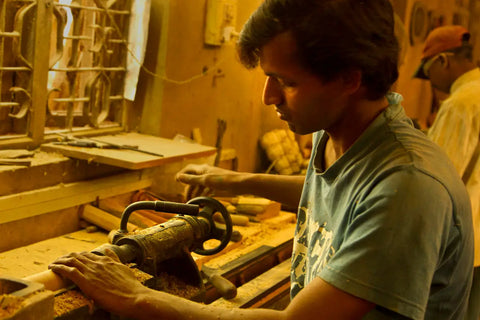 {Image credit: d'source}
{Image credit: d'source}
In the 1700’s the craftsmen in Germany introduced the craft of wooden toys. During this period, wooden toys were usually handmade for special occasions, but this notion then started to evolve across Europe with animals and dolls known to be popular handmade crafts at the time.
Throughout World War 2, the formation of wooden toys started to pause because of the manufacturing of newer toys with modern materials like plastic, metal etc. In spite of all the changes happening, wooden toys still have the same value and it is continuing to retain their heritage. Now it has become a trend that parents, relatives and children prefer gifting their children wooden toys so that they get to play without the influence of technology like video games and Tv games. Moreover children these days should also get the opportunity to play with wooden toys just like their parents and grandparents did, instead of just getting engrossed in technology.
The Indian States And Their Journey Of Wooden Toys
● Wooden toys of Bassi
Kumawat and Suthar, the handicrafts cluster of Bassi village within the Chittorgarh district, have been creating wooden toys and templated with natural for over four hundred years. Art items consist of 3 types: wooden toys, temples, and kavad or kawad (a transportable wooden toy shrine with several folds).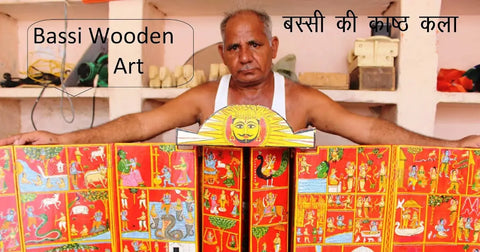
Kawad monks largely commissioned the kawad items and told mythological stories and folktales through paintings within the handcrafted temples made of wood. However, with the tree at the time found solely in some areas of the Aravalli hills, craftsmen have started using wood from the tree of meetha neem (curry tree) because it is additionally delicate and low in solidity. The toys were earlier painted with all the possible natural colours available but currently, they have created an approach for poster colours that are mixed with water and gum. A coat of clear varnish at the top completes the toy.
Wooden toys of Varanasi
In Kashi, Varanasi, on the banks of river Ganga, lies the oldest remaining town in the world. Moreover, it is home to ivory carvers whose ancestors earned a living carving ivory for the Mughal emperors. They shifted to wood carving once ivory was prohibited by the government and started making bright and vibrant lacquered toys within Heaven
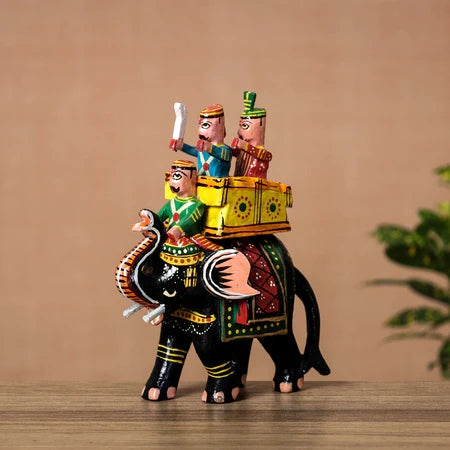
● Kinnal or Kinhala wooden toys of Koppal.
The hand- crafted wood craft of Kinhala, Kinnala or Kinnal, which acquire its name from the Kinhal village within the Koppal district, received the GI tag in 2012. It traces its origins to the fifteenth century once it absolutely was patronised by kings of the Vijayanagara Empire. Earlier, the artisans were creating three to four foot dolls. Currently, homes are a unit smaller and there's a requirement for smaller dolls measuring half-dozen to twelve inches, that artisans build. The softwoods from margosa, drumstick and poniki are used for the craft. All the elements of the doll area unit 1st joined beside a paste of Imli seeds and rock. Then, over the body of the doll, a paste known as kitta is applied to victimisation hands. The important procedure is finished with a final layer of stone powder paste. Many artisans still use natural colors while others have gone to market-made bright paints, which aren't all eco-friendly. a skinny layer of varnish is applied when the paint absolutely dries up.
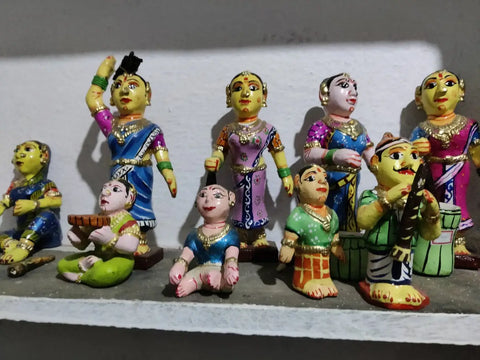
Image credit : Koppal district
● Wooden toys of Adilabad
Nirmal town’s Naqqash craftsmen and artisans have been creating exquisite wood toys for over four hundred years. The craftsmen’s families still create toys victimising poniki softwood sourced from forests around Nirmal. The toys area unit light-weight and not simply breakable. They largely depict nature like birds, animals, fruits and vegetables and also the daily life of folks. Toys are affixed with wooden blocks using bamboo sticks. Duco colours are used (natural colours were used earlier) and enamel gives them a shiny appearance.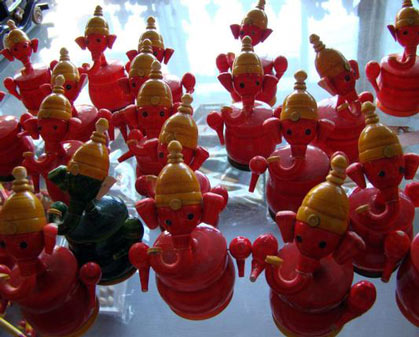
Image credit: mission Telangana
● Channapatna wooden toys from Ramanagara
The most celebrated and well-known toys from India are in all probability the Channapatna wooden toys that also are protected by a Geographical Indication tag. The art flourished beneath his reign. In recent times, its journeyman Bavas Miyan UN agency helped the native artisans with recently developed technologies improve the toys that helped Channapatana become nationally recognized. The toys were earlier created solely victimising soft dudhi or
ivory wood, which is white in colour. Artisans principally use the shaping machine for creating toys that were earlier coloured with vegetable dyes. The toys area unit is glazed by sprucing with abrasive property grass.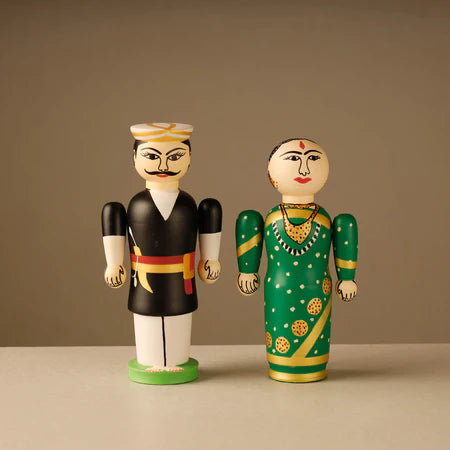
● Wooden toys of Natungram
Called kath putul, virtually wood dolls, these toys and figurines created in Natungram village are available with a large variety of themes from the spiritual to the recreational. Purchased wood owls retain long-lasting standing. The history of Bengal’s wood doll manufacturers goes back 250 years. It was easier to chop and chisel and conjointly cheaper. Artisans use two qualities of wood. A scholar tree, sand apple and mango wood square measure less strappy and at a lower price whereas beech wood, mahogany and sonajhuri , found within the dense jungles within the region square measure stronger and costlier. whereas the boy's square measure answerable for cutting, carving and chiselling the wood into form, ladies paint them. The wood is dried in the sun before creating the toys. Oil paints in daring colours like red, yellow, orange, inexperienced and blue have been used for hundreds of years. White and black colours square measure used for creating borders. Natungram wood toys are exported and even have sturdy domestic demand.
● wooden toys of Visakhapatnam
This woodcraft dates back to the eighteenth century. Artisans World Health Organization then lived within the Nakkapalli village, twenty-five kilometres from Etikoppaka, migrated to the present village within the twentieth century thanks to the well-endowed handiness of the soft ivory wood, regionally called Ankudu Kurra, within the near jungles. But once the landlords gave up the ghost, therefore, did the patronage. Today, solely a hundred and sixty families create Etikoppaka toys because of a scarcity of demand. The dried picket block is fastened on an electrical shaper victimisation badhiti, AN axe-shaped tool. it's then incised into the specified form employing a long metal chisel. Any remains of the wood scrap area unit smoothed with sandpaper.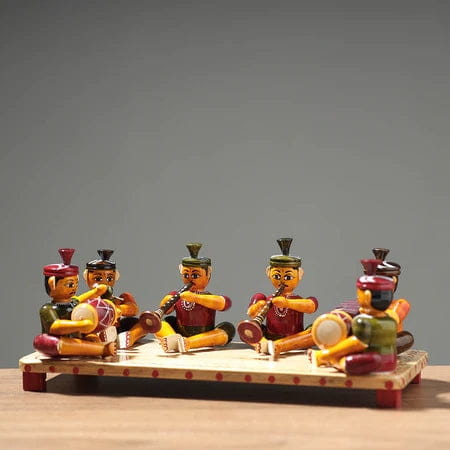
Benefits Of Wooden Toys
Plays With Imagination
One of the amazing experiences that the child gets from the wooden toy is that they are able to use their imagination. Playing is really important in a child’s early age, as it is great for their growth and overall development. Currently, there are a number of toys available for children that are suitable for their age group. In studies, it has been proven that visionary and creative play is essential for a child's cognitive development. Toys made of wood do not contain electronic parts or voice commands that can instruct your child. Role-play and imaginative play also help to bring out different types of intelligence, thinking, emotional and social skills. Some of the classic wooden toys, like building blocks and puzzles, help children with problem-solving and numeracy. Moreover, children also end up getting into physical activities while playing by running to toys instead of just pressing the buttons of remote control toys.
Environmentally Friendly
With the increasing environmental issues, as an active citizen, it’s important to be concerned about it. Generally, wooden toys are more environmentally friendly than plastic as they are biodegradable and can also be recycled. Instead of using something which will be great for the run, it is the right thing to choose. By doing this you can also play your part by saving the environment and at the same time, you can also pass on great values to your children as well.
Safety
When the child is in their growing age, it’s important to be more cautious towards them. It is much safer to use wooden toys than plastic ones because children tend to have the habit of putting everything they have in their hands directly into their mouths. And plastic toys sometimes, the cheaper ones especially break in their mouth which cuts to be sharp from the edges and can lead to causing problems for the child.
Durability and Longevity
As we all know that children are usually not that careful while playing and toys which are made up of plastic tend to break easily or get disfigured easily. On the other hand, wooden toys are very durable and don't break easily which obviously ends up saving you a lot of money and they can also be painted again if they get dull.
Wooden toys are cheaper
Yes, that is true! The upfront pricing of wooden toys might be higher than the plastic toys but if we think about the long-run benefits you will not only start buying wooden toys for your child but you will also end up buying for everyone else. The wooden toys can be passed on to your younger siblings, and your relatives. The maintenance of wooden toys is nothing if we compare it with plastic toys which require batteries, and electricity which eventually is expensive. Wooden toys are easy to maintain and can also be preserved for the longest time as well.
Timeless look and feel
Children love to experience and have things which are unique and have different
textures to it. Plastic toys are not of that different texture. And children know what that different texture feels like. Because of the durability it has, even after growing up, it can be kept in the room to have that childhood memory with you and also, and it adds an aesthetic feel to the room.
Making Wooden Toys
● Air Drying
The wooden boards are kept in the open air so that they can be air dried
naturally before any process of crafting begins. The process of making wooden toys starts when the entire moisture content from the wood falls down below 15 percent. It is important not to allow the wood to become moist before making wooden toys with it, so we'll wait until the moisture content of the wood falls below 15 percent.
● Shaping Blank
This process includes cutting raw wood into smaller pieces in the correct sizes and then it is moulded in the shape of toys. These uncoloured shapes which are
produced by the entire process are called ‘blanks’.
● Sanding
Each blank wooden toy piece goes into a sanding process to get purge all the
uneven parts and then it is made perfectly smooth for the next coating process.
● Coating
A wooden toy piece is ready for coating (or painting) once it is clean and smooth. First, the base coating is done. After that primer layer is applied, sand the toy pieces Tagain to get sure the surface of the coating is perfectly smooth, and then the second layer of coating is done. Each layer of coating is sanded before the next is applied, up to the final finish layer.
● Printing
Various techniques and tricks are followed for the printing of wooden toys.
● Engraving
Various elegant engravings are done on the wooden toys to make them more unique and aesthetic.
● Hand Painting
Hand Paintings are a personal touch that is a lot of times added to wooden toys to make them one of the best presents.
Care Tips For Wooden Toys
Before getting into the steps, let us understand why is it important to clean a toy. From an early age, children develop the habit of putting everything that is hand to hand directly in their mouth. These toys will surely go from the ground to their hands and after to their mouths very easily. Well... This is a natural behaviour, and we have all done this! And that is why it is important to clean toys and it is learned by growing and participating in daily home tasks. Keeping children's toys clean is crucial to protecting them from germs and dirt. Wood is durable, natural, and safe but it's also permeable. There is a totally different process involved in washing than in cleaning anything else. Since wood has a natural antibacterial quality, wood is less likely to get infected by germs than plastic toys.
How To Clean Wooden Toys?
● It is advised that you should never submerge the wooden toy in water, it might
expand, get disfigured, or lose its colour.
● For a basic cleaning which is done on a day to day basis, use a cloth and
warm water to wipe your wooden toys, then air dries them.
● For cleaning painted or varnished toys, it is advised to use mild soap for
cleansing.
● For Disinfecting the wooden toys it is advised to use apple cider vinegar and
it must be diluted with water and then air dried.
● Wooden toys can also be moisturised by using olive oil.
Conclusion
It is the sculpting and painting by craftsmen that make wooden toys so beautiful.
Perspectives are shown in them. Craftsmen create them based on their knowledge of Indian mythologies such as Ramayana, Mahabharata, and the Vedas.
Blogs you might also like:
banaras toy craftKahani' of The 'Khandani' Banarsi Wooden Artery
Worlds Greatest Invention Needle
 Verified Purchase
Verified Purchase






















Leave a comment (all fields required)